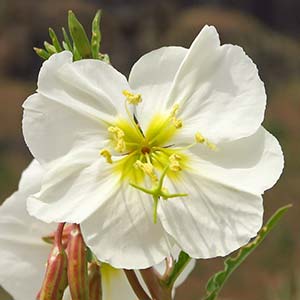Oenothera riparia
Oenothera pallida
mountain evening primrose, pale evening-primrose, rockweed brush, white-stem evening primrose
erect or ascending, usually many-branched throughout, proximal branches often somewhat spongy, 50–120 cm.
erect or ascending, single to several from base, unbranched or many-branched throughout, 10–50(–70) cm.
in a basal rosette and cauline, softly succulent, 4–13.5 × 0.8–2.1 cm, petiole 0–1.5 cm, blade lanceolate to elliptic-lanceolate, margins remotely denticulate.
cauline, rosette usually weakly developed or absent, at least during flowering, sometimes well developed, 1–5(–7.8) × 0.3–1(–1.5) cm;
petiole 0–2(–4.5) cm;
blade lanceolate, oblong, linear-lanceolate, or ovate, margins subentire or remotely denticulate, deeply sinuate-dentate, or pinnatifid, sometimes repand.
erect, flowers in axils of distalmost few nodes.
opening near sunrise;
buds with free tips 0.5–2(–5) mm, erect to spreading;
floral tube 14–20 mm;
sepals 20–30 mm;
petals bright yellow, fading pale pink or lavender, 16–27 mm;
filaments 10–15 mm, anthers 7–8 mm, pollen 85–100% fertile;
style 15–30 mm, stigma exserted beyond anthers at anthesis.
1–several opening per day near sunset;
buds nodding, weakly quadrangular, with free tips 0–2 mm;
floral tube 15–40 mm;
sepals 10–30 mm, not spotted;
petals white, fading pink to deep pink, broadly obovate or obcordate, (10–)15–25(–40) mm;
filaments 9–15 mm, anthers 3–10 mm;
style 25–55 mm, stigma exserted beyond anthers at anthesis.
oblong-clavate to oblong-ellipsoid, 4-angled or 4-winged, and wings 0.1–0.2 mm, 7–15 × 4–6 mm, stipe 2–5 mm;
sessile.
spreading to reflexed, straight to curved or contorted, cylindrical, obtusely 4-angled, tapering slightly from base to apex, 15–60 × 1.5–2.5 mm;
sessile.
0.8 × 0.4 mm.
numerous, in 1 row per locule, brownish with dark spots or black, narrowly obovoid, 1.5–2.2 mm.
= 56.
Oenothera riparia
Oenothera pallida
Oenothera riparia has not been accepted as a distinct species for a long time. The conservative approach used by G. B. Straley (1977) is here followed in recognizing a broadly delimited O. fruticosa, except that the very distinctive coastal tidal-freshwater semi-aquatic octoploid populations (Straley 1982) are recognized as O. riparia. Plants of these coastal populations, which occur from southern Virginia to North Carolina, are more robust, more branched, and less pubescent than those of the two subspecies of O. fruticosa, and have slightly succulent leaves and more prominent adventitious roots (Straley 1982; D. Boufford, pers. comm.). Further field studies and cytological analyses are needed to fully understand the geographical and ecological limits of O. riparia and confirm that it is strictly an octoploid species. K. N. Krakos et al. (2014) determined that Oenothera riparia is self-incompatible and is pollinated by bees (Bombus, Lassioglossum, Megachile, Parallelia, Xylocopa, and Zale).
(Discussion copyrighted by Flora of North America; reprinted with permission.)
Subspecies 4 (4 in the flora).
Oenothera pallida is a poorly understood species currently subdivided into four subspecies (W. L. Wagner et al. 2007) that differ largely in aspect, leaf division, capsule configuration, and pubescence. The variation pattern is rather complex with almost no diagnostic character uniformly distinguishing any one of the subspecies. Instead, each of the subspecies, which are mostly geographically separated although there is some level of overlap, have diagnostic suites of characters that maintain their linkage some of the time, but break down across the geographic area of each so that no single character uniquely identifies it. Each subspecies is characterized by leaf, pubescence, and, often, habit features. The issues with the integrity and intergradations of the subspecies are discussed below.
Oenothera pallida has been determined to be self-incompatible (W. L. Wagner et al. 2007), but K. E. Theiss et al. (2010) determined that although most populations of subsp. pallida are self-incompatible, one near Salt Lake City is self-compatible.
(Discussion copyrighted by Flora of North America; reprinted with permission.)
1. Herbs annual, sometimes perennial from a taproot, when perennial, sometimes with lateral roots producing adventitious shoots, strigillose throughout and villous distally, especially on flower parts. | subsp. trichocalyx |
1. Herbs perennial from a taproot and with lateral roots producing adventitious shoots, glabrous, strigillose, or sparsely villous. | → 2 |
2. Plants glabrous, sometimes strigillose, rarely sparsely villous; leaf blade margins usually subentire or remotely denticulate, rarely pinnatifid; capsules usually contorted to curved. | subsp. pallida |
2. Plants usually strigillose, rarely villous or glabrous; leaf blade margins shallowly sinuate-dentate or denticulate, or deeply sinuate-dentate to pinnatifid, rarely only dentate; capsules usually straight or curved, sometimes contorted. | → 3 |
3. Leaf blades (0.4–)0.7–1.5 cm wide, margins shallowly sinuate-dentate or denticulate. | subsp. latifolia |
3. Leaf blades 0.4–1(–1.5) cm wide, margins usually deeply sinuate-dentate to pinnatifid, rarely dentate only. | subsp. runcinata |
